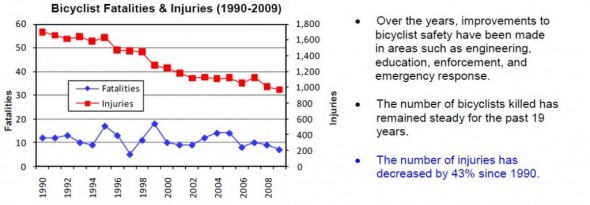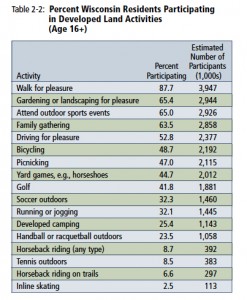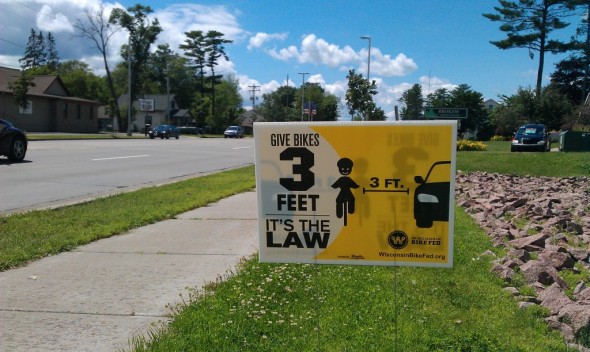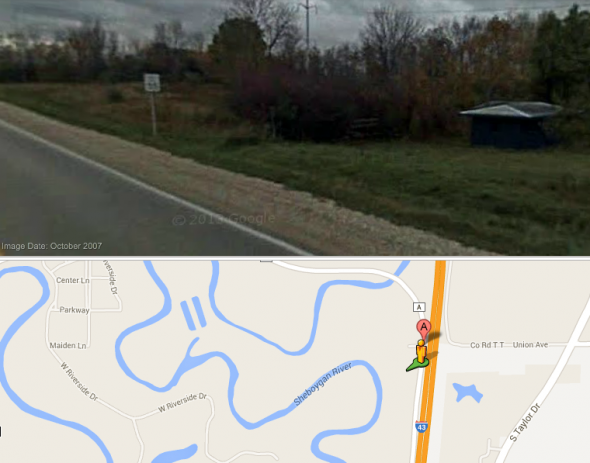The Decline of Bike Crashes
The ratio of bicyclists killed by motorists is actually declining. But more safety measures could still improve the numbers.
Terrible news again this week. Tom Held reports:
Motorist cited in crash that killed bicyclist in Sheboygan County
The Sheboygan County Sheriff’s Department cited a 55-year-old man for inattentive driving after a crash that killed a bicyclist on County Highway A in the Town of Sheboygan on Wednesday.
A release from the sheriff’s department identified the victim as Allen Redensek, 55, of Sheboygan. Read more here...
Despite all my recent reports, fatal bike crashes are really rare in Wisconsin. If you look at the statistics, riding a bike is actually incredibly safe, and keeps getting safer. The chart below shows the bicycle crash statistics for Wisconsin. Note the downward trend in the red line that shows all bicycle crashes.

Lifetime Odds of Accidental Death (Source National Safety Council)
Bicyclist 1 in 4,838 Car Occupant 1 in 242
Leading Causes of Accidental Death in the US (As compiled from data reported by the National Vital Statistics Report, Vol. 50, No. 15, September 16, 2002)
#1 Motor Vehicle #6 Drowning #9 Other Land Transport Accidents (including bicycling, walking, etc.)
Fatalities per Million Exposure Hours (Data compiled by Failure Analysis Associates, Inc.)
Motor vehicle travel: .47 Bicycle travel: .26

This report only counts people 16 and older, but still shows more than 2 million people ride bicycles every year in Wisconsin.
If there are only about 10 fatal crashes and 1,000 crashes annually out of the more than 2 million people who have safe and enjoyable experiences riding bicycles, why do I report about the rare instances where someone is killed? Are these reports just more fodder for fear mongers always warning people to be safe when they ride a bike?
Perhaps, but the Bike Fed staff is working to make Wisconsin an even better place to ride a bike. To us that means make it easier, more pleasant and safer. Many people still feel uncomfortable riding bicycles on roads where they have to share the road with cars. We can only make it safer if we look at the instances where crashes happen and try to implement countermeasures to reduce the chance of future crashes.
What countermeasures might we recommend to avoid future crashes at this location in Sheboygan? Given the man driving the car was cited for inattentive driving, the first thing we would suggest is more education and encouragement programs to get people to pay full attention when they are behind the wheel of a car. Far too many people use their time behind the wheel to multitask. They eat, text, talk on the phone, put on make-up, and I even have a friend who was ticketed for reading a book while driving! We need more education, more encouragement programs and stricter enforcement.

One of our Share and Be Aware yard signs encouraging people to obey the law that requires cars to pass bicycles by 3ft or more.
The other obvious component to improve safety involves engineering. The speed limit on Highway A, where this accident occurred, is posted 55 mph, and there is no paved shoulder. Best traffic engineering practices would suggest this road should have a 5 foot shoulder at a minimum to provide a reasonably safe place for people to walk, run and ride bicycles. Since there are so few cross streets, a fully separated side path would be even better and would likely result in many more people walking and bicycling along this stretch of road.

Posted 55mph and no shoulder, this Google maps image highlights a poorly engineered road. The engineers forgot to design for people walking and riding bicycles.
We want the take-away from our reports to inspire you to ride legally, be aware of where crashes happen and advocate for better education and better bicycle facilities in your communities. So please, don’t let our reports about fatal bicycle crashes scare you or keep you from riding you bike. Many statistics show riding a bicycle to be safer than walking down stairs, taking a shower and driving a car. When you factor in the health benefits and the reduced risk of obesogenic illnesses, your risk of dying goes down with every revolution you pedal.
This story was originally published by the Bicycle Federation of Wisconsin.
Bike Czar
-
Join a Bike Ride Under the Polish Moon
 Jun 1st, 2018 by Dave Schlabowske
Jun 1st, 2018 by Dave Schlabowske
-
9 Reasons to Join National Bike Challenge
 May 4th, 2018 by Dave Schlabowske
May 4th, 2018 by Dave Schlabowske
-
Biking Through the Mindoro Cut
 Apr 27th, 2018 by Dave Schlabowske
Apr 27th, 2018 by Dave Schlabowske





















I am a bike rider and am sympathetic to your point of view
BUT the stats here don’t exactly speak for themselves.
First of all, what about accidents per miles traveled. That will tell a different story.
Secondly, what accounts for the surprising decline of injuries. Maybe it is simply helmets and not bike lanes?
Also, MOST IMPORTANTLY the more bikes there are on the road (and there are a lot more) increases driver awareness of cyclists. That is probably the most important factor. Interesting, the recent fatalities have been a result of “driver inattention” in places with less bike commuting .
Also your stats only go up to up to 2008. Since 2008 cycling has increased dramatically which has lead to an increase in fatalities is some states.
FINALLY, your odds for accidental death in automobile v bike are wrong because they do not take into account the relative differences in usage of two modes of transport. What are the odds when a car and bike collide? 10 to 1, 50 to 1, a 100 to 1 in favor of the motorist.
I don’t think it is a good idea to give people the idea that biking is safer than driving. What makes biking safe is that we all know when we are riding how the odds are stacked against us.
Stacy,
I have to disagree with you about using crashes per mile traveled. I believe crashes per exposure hour are much more accurate because cars travel so much faster than bicycles. Comparing miles to miles is not a fair comparison when one mode goes so much faster.
Helmets: the cities that have the lowest crash rates in the world, tend to be the places with the lowest use of helmets. More nearby, a recent Michigan DOT 5-year study of bicycle crashes found no statistical difference in fatal or serious injuries between helmet wearers and those who were not wearing helmets. There are reasons for this and it mostly has to do with where people wear helmets and where they don’t. I am not arguing people should not wear helmets, or that helmets protect your head in a collision. I am just stating the results of the study.
Your last point I don’t understand. Of course in a crash between a bicycle and a car, the person on the bicycle is more likely to be injured or killed. That really has little to do with relative crash rates or injuries, since most crashes in cars do not involve bicycles.
To end on a positive note, I completely agree with your that the increase in number of people riding is most important because more people expect to see bicycles when driving. The more people who ride, the safer it is for everyone.
Is there a component in Wisconsin driver ed that addresses bicycle rights and responsibilities? If not, I would think it a sensible and possibly preventative measure.
Prudence,
Good question, but no, there is no requirement. Laws relating to bicycling and walking are in the Wisconsin Motorist Handbook, but there is no requirement that driver’s ed classes include the information in their curriculum, nor is there a requirement for a question on the drivers exam. Our Vulnerable User legislation addresses that issue, and we hope to make such questions mandatory on the test.
Meanwhile, the Wisconsin Bike Fed does attend the state drivers education instructor convention. We teach sessions there and provide curriculum to the other instructors so they can include it in their classes if they want to.
That said, my daughter recently took drivers ed, and was not taught anything about bicycle and pedestrian law. She took the test and it did not include any questions either.